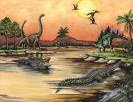A
forest is an area with a high density of trees.
Forests can be found in all regions capable of sustaining tree growth, except where natural fire frequency or other disturbance is too high, or where the environment has been altered by human activity.Forests can be classified in different ways and to different degrees of specificity. One such way is in terms of the "biome" in which they exist, combined with leaf longevity of the dominant specieshe latitudes 10° north and south of the Equator are mostly covered in tropical rain forest. As a general rule, forests dominated by angiosperms (
broadleaved forests) are more species-rich than those dominated by gymnosperms (
conifer,
montane, or
needleleaf forests), although exceptions exist.

Arctic tundra occurs in the far Northern Hemisphere.The tundra is a very windy area, with winds often blowing upwards of 48–97 km/h (30–60 miles an hour). However, in terms of precipitation, it is desert-like, with only about 15–25 cm (6–10 inches) falling per year (the summer is typically the season of maximum precipitation). During the summer, the permafrost thaws just enough to let plants grow and reproduce, but because the ground below this is frozen, the water cannot sink any lower, and so the water forms the lakes and marshes found during the summer months. Although precipitation is light, evaporation is also relatively minimal.




it is nice
ReplyDeleteguoxuan